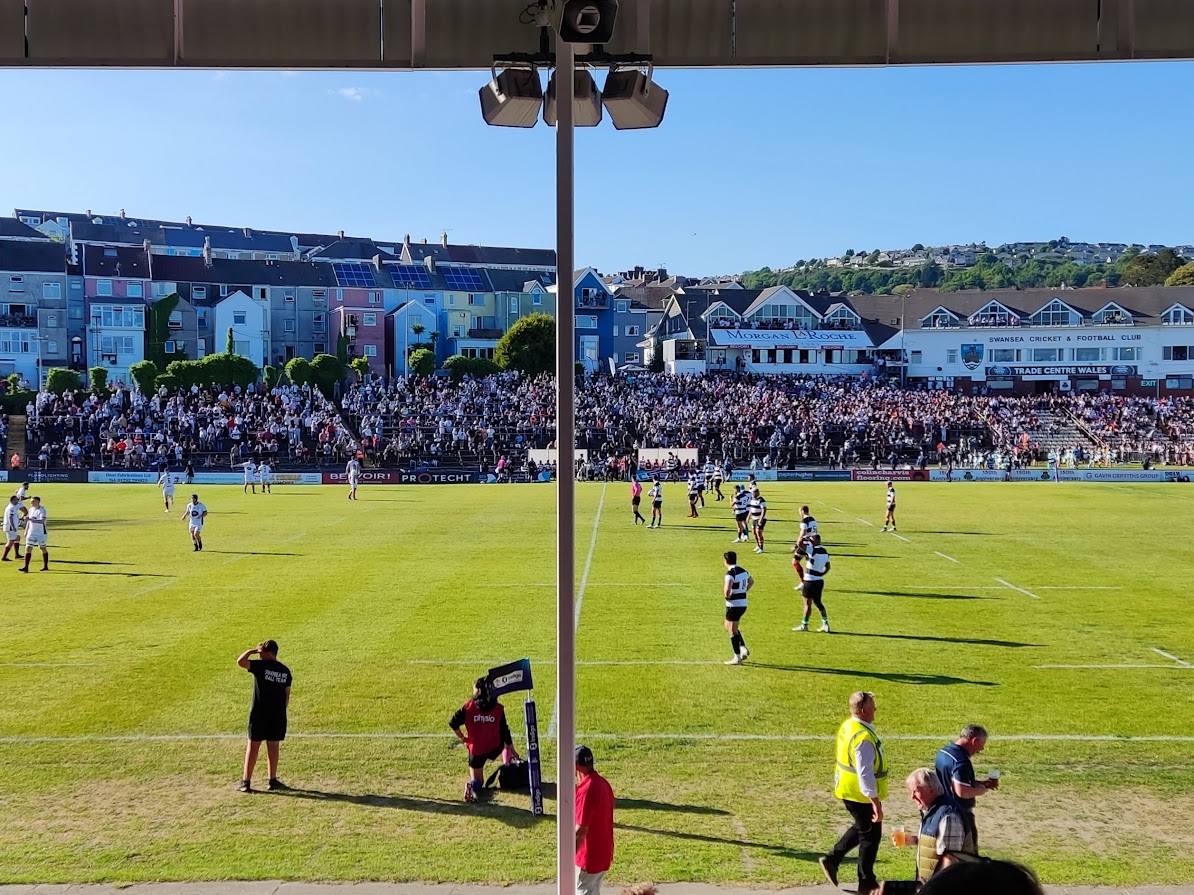By Huw Richards
It was a chance to relax, to briefly escape the political and economic ills besetting, along with much else in British life, rugby union in Wales.
A bright, warm evening completely unlike the last full international at St Helen’s, an atrociously cold and sodden encounter with Tonga in 1997.
The venerable venue can rarely have looked better. The sun lit up the brightly-painted backs of houses in Bryn Road, with crystal blue sky above the Townhill skyline.
There was action to match as Swansea and the Barbarians combined for more than 100 points for the first time in 83 matches spread across 123 years.
The mood was relaxed. That 68 of the points, and the bulk of body-swerving deception and dextrous offloads came from the Barbarians, was only to be expected when top-line professionals face the team which finished 11th in the Welsh Premiership.
THE BAABAAS!!!🏉
And we’re off! Swansea RFC v Barbarians RFC, 2023, celebrating 150 years of the ‘All Whites’ is underway. They first played back in 1901 and the most recent encounter took place in 1994! Welcome back to the Baabaas!@Barbarian_FC @SwanseaRFC @SwanseaCouncil pic.twitter.com/r6GDrusnCn— Sport and Health Swansea (@Sport_CCS) May 31, 2023
But the All Whites did their share, keeping a crowd of more than 6,000 cheerful, and averting the jeopardy voiced around the hour by one spectator, “We don’t want 100, do we.”
But it was also a time for retrospection and reflection. In part this was because this was certainly Bradley Davies’ last game, and quite possibly also Alun-Wyn Jones’s.
Alun-Wyn is so much an icon of the Regional Franchise era that it was almost as a surprise to be reminded that as well as his marathon stints for Wales and the Ospreys, he pulled on the All White shirt 35 times and is a worthy successor to a magnificent line including Billy Bancroft, Dicky Owen, Haydn Tanner, Clem Thomas, Mervyn Davies and Robert Jones in club affiliation as well as birthplace.
But even without him, this would have been a time and place for reflection. It was the final on-field event of Swansea’s 150th anniversary season.
A pop-up stall sold “White Gold”, club archivist David Dow’s superbly researched account of the first 15 years, which resurrects history lost in the 1941 Blitz.
It’s all over at St Helen’s!
Swansea RFC 33-68 Barbarians RFC
Alun Wyn Jones played for both sides in an action-packed match ⚪⚫#BBCRugby pic.twitter.com/YFZhDHrk3s
— BBC ScrumV (@BBCScrumV) May 31, 2023
All Whites debutants on the night were proclaimed numbers 3,012 and 3,013 in a list starting with those pioneers of 1872.
And the fixture itself was a throwback, the first time the Barbarians – annual visitors for most of the 20th Century as part of the cherished pre-professional era ritual of the Easter tour – had visited since 1994.
Spectators old enough could summon up memories like Mervyn Davies shooting unstoppably from the back of a scrum to score in 1973 and Rosslyn Park wing Martin Offiah displaying the talent shortly to prove irresistible to Widnes’s chequebook-wielder with a hat-trick around a decade later.
My late father recalled Whites fans at one tough encounter – if open play was mandatory, these were still serious contests between players with the competitive instincts of elite sportsmen – advising the visitors to, “Go back to bloody Barbaria!”
And while every sporting venue has its ghosts, history presses most vividly at those like St Helens and the Stade Colombes which no longer enjoy their former status.
To visit after a long break was inevitably to be reminded not only of personal experience dating back to Clive Rowlands’ craft and Doug Rees’s goal-kicking defeating Neath just after Christmas 1967 and Eifion Jones’s match-winning sixes against Middlesex propelling Glamorgan towards the County Championship in 1969, but all that came before.
One off the bucket list✅Playing for the @barbarians_fc for the first time with some great players and friends throughout my career class to play at a full house St Helens great few days with the 🐑🐑boys to wear Rhayader rfc socks was where it all started for me 🐏🏉#grateful pic.twitter.com/OspIffeERY
— Dan Lydiate (@dan_lydiate) June 1, 2023
Structures may have changed and capacity plummeted, but St Helens retains the echoes of Wales games from 1882 to 1954 – the James brothers, the Dancing Dicks, the All Whites becoming the first team in the world to beat all of the All Blacks, Wallabies and Springboks, Don Shepherd, and Glamorgan beating South Africa and Australia in the 1950s and 1960s.
Also, to be fair for just a moment, Gary Sobers, and the 1924 All Blacks.
To watch this revival of a once-hallowed fixture was also inevitably to wonder if it will ever happen again.
Prediction is a mug’s game, making fools of the most sophisticated. Would anyone at the match against Fiji in 1973 have believed that 50 years hence the All Whites would be subordinated to a club named after the rare bird of prey on the special Centenary jersey?
But this, amid the grimly vexed issue of how rugby union in Wales structures and funds itself, is a question for another time.
However little or much is left for the Whites and the ground with which their history is intertwined, it has been some journey.
Wednesday night was a happy addition to that record.
Last Of The Summer Wine For Alun Wyn As Fans Drink It All In At St. Helen’s





